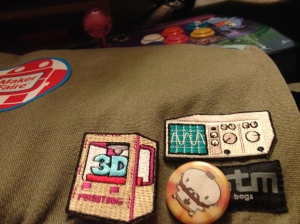Grades, Badges and Environments of Trust
This morning a colleague asked, innocently enough, “have you thought at all about learning badges?”
Ka-POW
Nerd sniped!
Combine that simple question with Jim Groom’s great post about #ds106 ‘s unique place on the shifting cost/value curve of higher education, and it turns out that I’ve thought a lot about <obligatory> steenkin’ badgers </obligatory>, especially in the context of a brick & mortar school.
Badges are just hipster grades, right?
Badges suggests a granularity and flexibility that’s distinct from traditional classroom grades, which are two entirely positive adjectives in my world. Couldn’t we replace the Devastator B+ with a sea of specific and useful Constructicon badges?

Photo Credit: mdverde
That view pushed me towards SBG years back, as I recognized how much information (how much feedback!) I was throwing away when I summed up the question by question analysis of my math tests into one lump score. Not only is there more value for a learner in 12 skill scores, there should be value for teachers, parents and observers as well. Finally, a better response for the parent conference rebuke, “They were a B+ student last year!” If grades describe a student’s understanding*, then more granular grades yield a more nuanced view of that student’s skills and give enough information to teachers to build the right learning environment.
I really want to think that’s true. But to curb my runaway optimism, I look at how much energy schools spend vetting the information shared within our own organization (homogenized exams for all Algebra classes, annual placement exams, restricted course registration) and how little currency that information has for other organizations. I don’t know if an exponential increase in the number of grades would improve things.
The meaning/reliability of a badge is inversely proportional to the product of it’s scope, utility, and value.
At christmas, Jodi bought me a collection of neat nerd badges from Adafruit. While Adafruit has developed a collection of interesting learning resources for their products (and, tangentially, their badges), those exist as fascinating and elaborate backstory for a decorative product. I stitched the oscilloscope badge onto my bag after my first successful waveform reading, even though my Father’s Day scope looks very different. My Adafruit badges live on my bag, not my resume, sitting right next to the chibi Zangief for the exact same reasons. Do you like Street Fighter enough to recognize the Red Cyclone? Do you like oscilloscopes and 3D printers? We should be friends, and have a clubhouse and drink Sunny D!
I have a Daisy Girl Scout in my house, so I have a chance to award some badges as well. There’s a Girl Scout store where you can walk in and buy almost any badge. Girl Scouts have published expectations for how girls might earn each badge, increasingly so as the girls progress through the scouting system, but those are loose associations at best. The sash’s value as a record of learning and experience is derived entirely from the trust between troops and troop leaders. One of the things that enables this trust is the relatively low rewards that go along with most Girl Scout Badges. If a new girl moves into your troop, there’s no obvious incentive for her to forge a flair-laden sash. We accept those badges in good faith and, over time, will see how they relate to her actual interests and skills. For the Gold Award, which is big deal time for Girl Scouts, the standards are more stringent and communication between the girl, troop and council are extensive. A successful Gold Award project generates a meaningful and visible effect on individuals and communities. The strictures of the Gold Award program are scaffolding designed to help young women create something that should be impossible to hide. Any badge, even the Gold Award, should serve as a memento, not an affidavit.
There’s this great Open Badges Initiative from Mozilla that’s approaching learning badges as a big picture social/technical infrastructure challenge. Their baseline goal, to allow individuals to maintain a “badge backpack” that documents their abilities and interests over time, sounds great, doesn’t it? It’s run by smart, approachable people pursuing a vision, building an infrastructure for the next century of learning.
Any system that assigns score or delivers value will attract scams, spoofs, and bad actors over time. Whenever I think we’ve acclimatized to how that law interacts with high school grades, there’s another editorial page hubbub about the loss of the “gentleman’s C” or a news story about schools falsifying test results. Not only does college admissions drive huge chunks of the high school experience, but the push for hyper GPA, continuous test prep, and specious extra-curriculars devalue the student behaviors that admissions metrics were designed to highlight.
Can you imagine how an open badge system would warp under those pressures? Here, I brought it back from the future for you. Entire subcultures dedicated to maximizing the utterly meaningless Xbox Gamerscore number, with all the factional disputes you might expect . True Achievements is like a “make them earn the A” professor, remapping the value of every Achievement so that the seriously dedicated can separate themselves from the pack. (As full disclosure, here’s my TA profile. I am not dedicated)
For gamers in that culture, people who “just play” games without boosting** seem completely irrational, like HS students who eschew SAT prep classes or elite travel soccer teams. In a world where every metric will be maximally exploited in direct proportion to it’s value, the points that don’t matter can matter a whole lot.

To be clear, I’m not suggesting that the existence of Gamerscore invalidates Mozilla badges as a project or a product. Instead, I just want to highlight on the difference between a system that serves a small pool of trusted actors, and a truly open one, where participants at every level operate according to their own diverse (perverse?) incentives. I want to use Open Badges as a tool that deepens and gives context to the relationships within our school community, not as a transcript replacement.
Doug Belshaw, an Mozilla “evangel[ist] for Open Badges in Europe,” describes the badges as “metadata infused credentials.” If that’s going to work for schools, then we need to get to work now on opportunities for our students to create meaningful, interesting bits of data that are badge ready! When students work in public, receive feedback in public, make mistakes and learn from then in public, then the metadata trail provided by the badge not only provides justification, but can serve as a window into the students’ entire portfolio.
Let the protocols simmer for a while. Let’s stay clear of commercial providers, eco-system hustlers and the noxious 1st-gen implementations that offer nothing more than a sickly gamified clown sweater stretched over the Common Core.

Photo credit: loren via wil wheaton
All that crap will just annoy human users and set up an even larger fight down the road, when everyone just remembers that “we tried badges and they sucked.”
If OBI develops and pays off, then any school with publicly accessible student portfolios will be able to layer badges over student work as easily as DS106 tags assignments. If OBI withers, if some Kahn/Pearson love child dominates the space and defines badges as gamified micro-grades, then your school will be even better off! Instead of forcing students’ rich learning experience through the PlayDoh pasta extruder, they’ll have built a whole universe of authentic, open, and inhabited portfolios. The tools you need to bring the heart of students’ learning experience onto the open web are literally free.
Badges can serve as markers of identity, reveal hidden interests or skills. Badges can spark surprising connections between individuals and organizations. Even as a marker of assessment, badges can serve to complicate our too-placid notion of what counts as learning or success.
But badges are only lenses that focus on different aspects of the community they serve. Obscure badges can’t create a learning environment that values and celebrates diverse experience. Badges can introduce the founders of Street Fighter Crochet club, but they won’t sustain it.
Many K12 schools are desperate for ways to signal the arrival of 21st century learning, and a augmenting grades with a collection of vector art badges can seem heaven sent. But schools committed to reshaping into hubs student-driven learning will ignore that temptation, eschew the PR bump and focus instead on helping faculty and students to learn, strive, fail, and grow on the public web. Without that library of authentic public learning experiences in readily linkable forms, badges will never be more than weak-sauce gamified crap.
* They don’t
** There’s some fascinating tidbits in boosting circles, surrounded by a vast see of depressing, base competitiveness and desire for identity and control. If you’re looking for further EDU comparisons, consider Microsoft’s mandate that all Xbox games come with a fixed number of Achievement points (100 for retail games), but set no standards for how they’re awarded to players. Hence – Avatar: Burning Earth, a sub-mediocre piece of kids shovelware based the great animated series, notable only for the easily exploited Achievements.
Six years after relase, the 360 version of this utterly forgettable game fetches collectible prices on Ebay/Amazon while the identical PS2 version (with no achievement system) languishes under $5. Does mean 1000 Gamerscore points has a market value of $25?
*** In my last round of reference searching, I discover that Bud posted a similar set of concerns two years back, with far more clarity. Of course he did!










